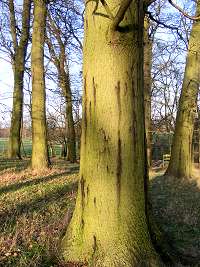| Acute oak decline | |
|---|---|
 Stem bleeding in a tree affected with Acute oak decline Stem bleeding in a tree affected with Acute oak decline | |
| Causal agents | Brenneria goodwinii and Gibsiella quercinecans |
| Hosts | Oaks |
| Distribution | United Kingdom |
Acute oak decline (AOD) is a disease that infects oak trees originally described in the UK. It mainly affects mature oak trees of over 50 years old of both Britain's native oak species: the pedunculate oak (Quercus robur) and the sessile oak (Quercus petraea). The disease is characterised by the trees bleeding or oozing a dark fluid from small lesions or splits in their bark. Unlike chronic oak decline, acute oak decline can lead to the death of trees within 4 to 5 years of symptoms appearing. The number of trees affected is thought to number in the low thousands, with a higher number of infected trees being found in the Midlands.
Causes of the disease
Acute Oak Decline is a complex tree decline disease that cannot be explained by a single cause. It results from a combination of environmental factors weakening the trees and some biotic factors.
Bacterial pathogens
Two different species of bacteria, Brenneria goodwinii, Gibbsiella quercinecans, are repeatedly found in the decaying tissues of trees with AOD. Laboratory experiment confirmed that these two species have the ability to cause tree tissue necrosis and possess virulence genes commonly found in plant pathogens. In addition to these two bacterial pathogens, the other microbes present in AOD affected trees is different from non-infected ones.
Bark-boring beetle

Most trees affected by AOD will display exit holes and galleries caused by the larvae of the two-spotted oak borer Agrilus biguttatus. Larvea of A. biguttatus and the bacterial pathogens are acting together in causing the disease, with the bacteria being more virulent and causing larger lesions when trees are infected with beetle larvae. Researchers are still investing the potential role of A. biguttatus as a vector of the bacterial pathogens.
Drought and nutrient limitation
As other oak decline disease, AOD usually develops after the tree is being weakened by some environmental factors, called predisposing factors, such as water and nutrient limitation.
See also
References
- "Symptoms of chronic oak decline". Forest Research. Retrieved 2009-09-26.
- Denman, Sandra; Brown, Nathan; Vanguelova, Elena; Crampton, Bridget (2022), "Temperate Oak Declines: Biotic and abiotic predisposition drivers", Forest Microbiology, Elsevier, pp. 239–263, doi:10.1016/b978-0-323-85042-1.00020-3, ISBN 978-0-323-85042-1, retrieved 2024-01-19
- Brady, Carrie; Arnold, Dawn; McDonald, James; Denman, Sandra (July 2017). "Taxonomy and identification of bacteria associated with acute oak decline". World Journal of Microbiology and Biotechnology. 33 (7): 143. doi:10.1007/s11274-017-2296-4. ISSN 0959-3993. PMC 5486618. PMID 28623563.
- Denman, Sandra; Doonan, James; Ransom-Jones, Emma; Broberg, Martin; Plummer, Sarah; Kirk, Susan; Scarlett, Kelly; Griffiths, Andrew R; Kaczmarek, Maciej; Forster, Jack; Peace, Andrew; Golyshin, Peter N; Hassard, Francis; Brown, Nathan; Kenny, John G (2018-02-01). "Microbiome and infectivity studies reveal complex polyspecies tree disease in Acute Oak Decline". The ISME Journal. 12 (2): 386–399. Bibcode:2018ISMEJ..12..386D. doi:10.1038/ismej.2017.170. ISSN 1751-7362. PMC 5776452. PMID 29028005.
- Denman, Sandra; Plummer, Sarah; Kirk, Susan; Peace, Andrew; McDonald, James E. (2016-10-01). "Isolation studies reveal a shift in the cultivable microbiome of oak affected with Acute Oak Decline". Systematic and Applied Microbiology. 39 (7): 484–490. doi:10.1016/j.syapm.2016.07.002. ISSN 0723-2020. PMID 27553488.
- Broberg, Martin; Doonan, James; Mundt, Filip; Denman, Sandra; McDonald, James E. (2018-01-30). "Integrated multi-omic analysis of host-microbiota interactions in acute oak decline". Microbiome. 6 (1): 21. doi:10.1186/s40168-018-0408-5. ISSN 2049-2618. PMC 5789699. PMID 29378627.
- Denman, S.; Brown, N.; Kirk, S.; Jeger, M.; Webber, J. (2014-10-01). "A description of the symptoms of Acute Oak Decline in Britain and a comparative review on causes of similar disorders on oak in Europe". Forestry. 87 (4): 535–551. doi:10.1093/forestry/cpu010. ISSN 0015-752X.
- Doonan, James M.; Broberg, Martin; Denman, Sandra; McDonald, James E. (2020-08-26). "Host–microbiota–insect interactions drive emergent virulence in a complex tree disease". Proceedings of the Royal Society B: Biological Sciences. 287 (1933). doi:10.1098/rspb.2020.0956. ISSN 0962-8452. PMC 7482278. PMID 32811286.
- Brown, Nathan; Vanguelova, Elena; Parnell, Stephen; Broadmeadow, Samantha; Denman, Sandra (January 2018). "Predisposition of forests to biotic disturbance: Predicting the distribution of Acute Oak Decline using environmental factors". Forest Ecology and Management. 407: 145–154. doi:10.1016/j.foreco.2017.10.054.
Further reading
- Brady, C.; Denman, S.; Kirk, S.; Venter, S.; Rodríguez-Palenzuela, P.; Coutinho, T. (2010). "Description of Gibbsiella quercinecans gen. nov., sp. nov., associated with Acute Oak Decline". Systematic and Applied Microbiology. 33 (8): 444–450. doi:10.1016/j.syapm.2010.08.006. PMID 21115313.